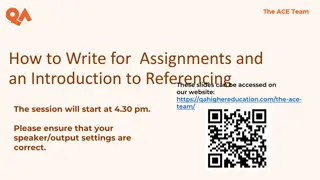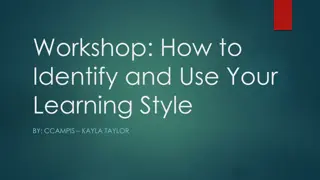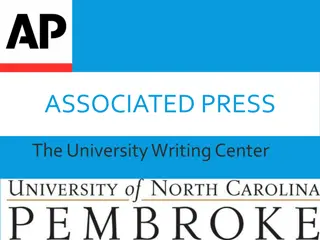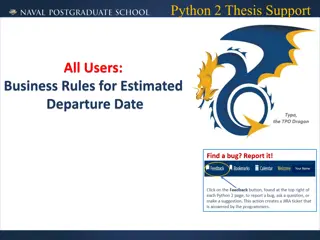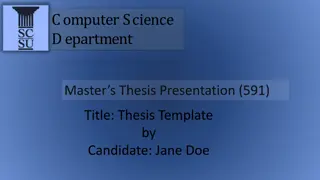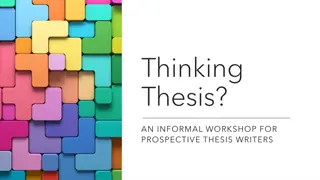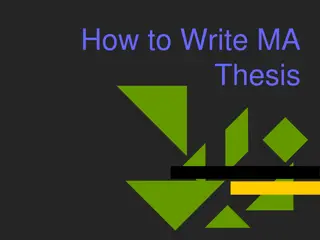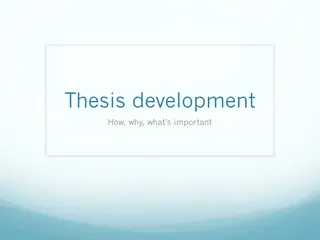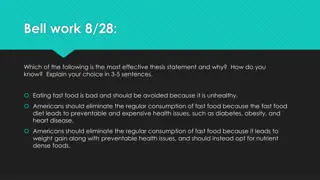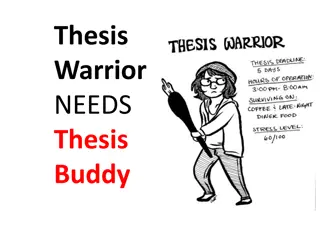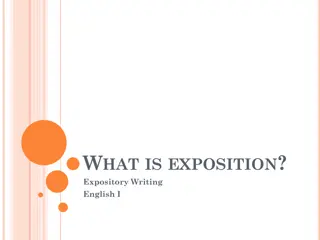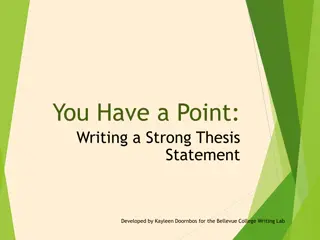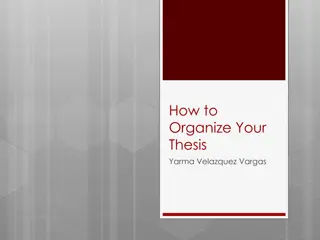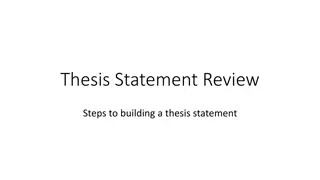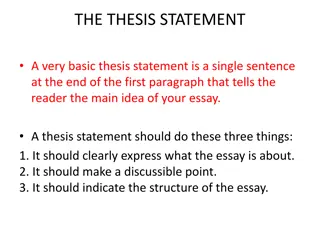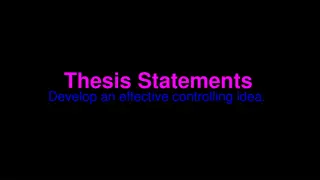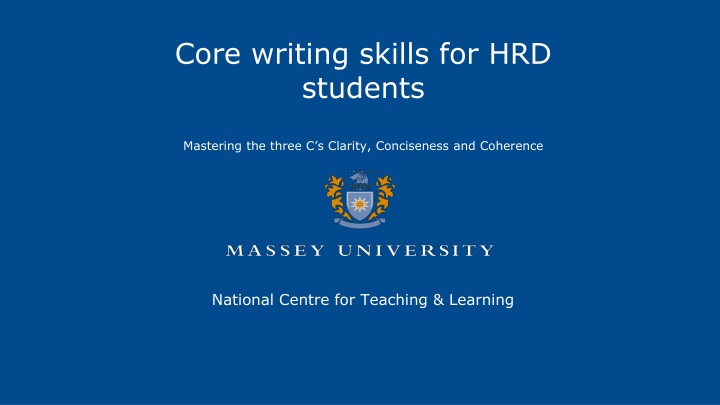
Mastering Core Writing Skills for HRD Students: Clarity, Conciseness, Coherence
Enhance your writing abilities with tips from Massey supervisors and principles of clarity and conciseness. Engage in group discussions on writing experiences, feedback handling, and relevant thesis writing tips.
Uploaded on | 2 Views
Download Presentation

Please find below an Image/Link to download the presentation.
The content on the website is provided AS IS for your information and personal use only. It may not be sold, licensed, or shared on other websites without obtaining consent from the author. If you encounter any issues during the download, it is possible that the publisher has removed the file from their server.
You are allowed to download the files provided on this website for personal or commercial use, subject to the condition that they are used lawfully. All files are the property of their respective owners.
The content on the website is provided AS IS for your information and personal use only. It may not be sold, licensed, or shared on other websites without obtaining consent from the author.
E N D
Presentation Transcript
Core writing skills for HRD students Mastering the three C s Clarity, Conciseness and Coherence National Centre for Teaching & Learning
Contents Writing experiences Writing tips from Massey supervisors Principles of clarity and conciseness Applying the principles
Discuss in your groups 1) How many hours have you spent writing per week over the last few months? 2) Can you name one thing that s helped and one thing that s hindered your writing? 3) Have you received any stinging feedback on any of your thesis writing so far? If so, how did you respond?
WRITING TIPS FROM MASSEY SUPERVISORS Complete the thesis writing advice from Massey supervisors handout by putting ticks or crosses next to each tip . Discuss your answers in your groups. Which tips do you think are most / least relevant to you?
Supervisors advice (X means the advice was the opposite of whats here) Insist that your supervisors read and return drafts within a reasonable timeframe. 1 Wait for all results to be in before starting to model the data or thinking about possible interpretation. 2 X Start writing the acknowledgements section only at the very end to ensure that you ve included all significant contributions from colleagues etc. 3 X Use the MS Word Master document feature to link the different chapters and quickly create lists of contents, figures and tables. 4 X Buy a basic writing book to ensure that you have mastered the use of apostrophes, semi-colons, etc. 5 Remember that, ultimately, it s your thesis, and you are the one who has to make the decision about when it is ready to be examined. 6 X Students need to concentrate on the basics: identify a problem, summarise what has been done and explain how their study goes beyond existing research. 7 Prepare how you d explain your thesis in 30 seconds to someone you met in the elevator; this will help you gain a clear sense of your overall narrative. 8 To help you achieve flow, aim to write a minimum of 1000 words in a single session, without worrying about quality; that can come in later at the revision stage. 9 X Don t spend too much time on the introduction; as an examiner, I only really start to pay close attention once I ve reached the lit review. 10 X Write as much as possible from memory, so that you avoid writing from references . 11 Remember that you are writing for a sympathetic and tolerant reader - don t imagine that anything you write might be used against you in the exam! 12 X
Selected comments by PhD supervisors for each question 1) The original word used by the supervisor was a sensible time. 2) The supervisor explained that: It is also important to not wait for all results to be in before starting to model the data or thinking about possible interpretations. Candidates should be proactive in thinking about a range of possible outcomes and the resulting range of possible interpretations, even before the experiments start. That way anticipated outcomes have already interpretations associated with them, making it easier to write them up. 3) The supervisor explained that: Acknowledgments section can be started early, so as to not forget input from colleagues etc.
Selected comments by PhD supervisors for each question 4) The actual advice was: Formatting takes a long time. Work with individual chapters and keep them as separate files. I advise against using the MS Word Master document feature that links those files in order to quickly make tables of figures, tables, and contents. This table is easily made in the end, manually, only takes a couple of hours. I almost lost my thesis due to file corruptions occurring as part of a Master document . 5) One supervisor explained that: it sounds basic but it is so irritating, and upsets the flow of the material and examiners get frustrated (not a good thing). Another mentioned: Examiners tend to pick up on small issues typographical usually. Students should work hard to make sure their copy is clean as possible. For me, if I am distracted by the form then I'm distracted. Therefore remove the distractions and let the text the flow.
6) The supervisor recommended that candidates: accept that you will not be allowed to submit when you think the thesis is ready but you will be so grateful to your supervisor when you see the final product. 7) The supervisor lamented that: the majority of the time students just simply list all their readings. 8) The supervisor s advice was: Having a clear sense of your overall narrative is really helpful e.g one of, or a combination of: 30 second elevator pitch; a one-page synopsis of your thesis, a flow chart; a table of contents.
9) The supervisor suggested: Consider breaking the writing task down in to small, quality chunks e.g 300 or 500 words a day. It makes the task manageable, achievable and you can concentrate on writing quality. 10) The actual advice was: Opinions differ, but as an examiner, a really strong clear introduction puts me at ease. I think a useful template is What is the problem? Why is it important (and to whom)? What am I going to do about it (theoretical, methodological, frameworks)? How will this help (contribution)?
11) The supervisor said: Most students (including native English speakers) tend to write from references (instead of using references as support), do not ask themselves What will the reader understand? , and have a copy and paste culture. This translates into illogically structured paragraphs full of redundancies and irrelevant information that just distract and confuse their readers. Just write from memory, then use references as evidence. In fact you should disconnect from the net when writing. 12) The actual advice was: Remember Everything can and will be used against you : that includes anything that ve you read and repeated but did not fully understood, but also very simple extra information in Figures, tables etc.
WRITING TIPS FOR CLARITY
Precise information Literary experts disagree as to whether X or Y was the greatest writer of the industrial period. Literary experts disagree as to whether X or Y was the greatest English writer of the late Colonial period. The experimental trial was preceded by a set of instructions. Prior to the experimental trial, the researcher read out a set of instructions to the participants. (Walters, 1999)
Precise words Farmers will need to address methane gas emissions. (Think about, discuss, solve) The researcher was able to access participant data. (open, enter, retrieve-file) This chapter will discuss human capital. (Describe, outline, examine) Self regulated learning is an area that is well researched. (concept, theory, approach, branch of education) The researcher asked for participants input in the focus group. (opinions, ideas, views, solutions)
Avoid Informal Phrasing fairly little ... longish ... that is how ... made lots of.. of all sorts ... back up ... sorted ... relatively limited ... extended ... thereby ... produced multiple ... of various types ... underpin .. categorised ...
Focused sentences: Whats wrong with this? In the 1960s when little study was devoted to facial expression, like most social scientists of her day, Mead believed expression was culturally determined, we simply use our face according to a set of learned social conventions, grew from the emphasis on motivation and cognition in academic psychology that flourished at the time.
In the 1960s, little study was devoted to facial expression. Like most social scientists of her day, Mead believed expression was culturally determined. In other words, she believed we simply use our face according to a set of learned social conventions. This belief grew from the emphasis on motivation and cognition in academic psychology that flourished at the time.
A paragraph without bell-ringing The task of examining this during speech and singing can be accomplished through temporal-acoustic measures. Voice onset time (VOT) has been established as an important way of distinguishing both of them. It is defined as the interval between the release of an oral constriction of these and the start of vocal fold vibration for the following sound. When examining it, it is important to realize that three value ranges may be observed .. In English, they can be observed in voiced stops, but only positive ones are observed in voiceless stops. Its effectiveness as a tool to help them distinguish them according to this and that has been thoroughly examined. based on McCrea & Morris, 2007, p. 55
The same paragraph with bell-ringing The task of examining the articulation of consonants during speech and singing can be accomplished through temporal-acoustic measures. Voice onset time (VOT) has been established as an important acoustic measure used to distinguish voiced from voiceless stop consonants across a variety of languages. VOT is defined as the interval between the release of an oral constriction of a stop consonant and the start of vocal fold vibration for the following vowel. When examining VOT, it is important to realize that three VOT value ranges may be observed .. In English, all three of these VOT ranges can be observed in voiced stops, but only positive VOTs are observed in voiceless stops. The effectiveness of VOT as a tool to help researchers and clinicians distinguish stop consonants according to voicing and place of articulation has been thoroughly examined. McCrea & Morris, 2007, p. 55 (original version)
Making your writing clear and concise can be hard work! "I don't write easily or rapidly. My first draft usually has only a few elements worth keeping. I have to find what those are and build from them and throw out what doesn't work, or what simply is not alive. Susan Sontag "There are days when the result is so bad that no fewer than five revisions are required. In contrast, when I'm greatly inspired, only four revisions are needed." John Galbreath These & more quotations on rewriting can be found at: tinyurl.com/dbqk4k
More concise academic style involves Using powerful, specific words instead of several vague ones Removing redundant words Removing unnecessary modifiers/qualifiers Reducing tentative or informal phrasing Reducing repetition . and will reduce word count up by 10 % +
Another way this research methodology is limited, looking at it from an ethnographic angle ... Another methodological limitation, in ethnographic terms ...
Another similar weakness, which we looked at before, is the fact that the researcher has not looked into the particular culture that this teacher has developed his way of teaching in. And a related limitation, already noted above, is the lack of exploration of the specific culture in which this teacher has developed his pedagogic system.
Using more impersonal constructions ... has not looked into ... might have seen him as ... .... is left relatively unexplored ... might have been considered ...
Rich data like this ... Other researchers, like Woods (1998) ... the way Borg just listed them missed out on the way the different levels affect each other It is such rich data ... Other studies, such as Woods (1998) ... In Borg s list approach, the interaction of the different elements is left relatively unexplored
This strategy can reduce the word count dramatically Wordy version in casual English style Teachers play a big part in how motivated their students feel about the subject. According to a study carried out by Nikolov in 2001, even if students are really motivated to begin with, if the teacher goes about things in a really boring way, the students end up becoming less motivated learners. (52 words) Concise version in academic English style Teachers can influence the motivation of their learners. Nikolov (2001) found that initially positive attitudes to language learning were negatively impacted by the teaching methodology. (25 words)
A paragraph where each sentence moves the argument on Cognitive theories of motivation, on the other hand, seek to explain motivation to learn language in relation to learners beliefs about their abilities (Dornyei, 1994, p. 276). Perhaps the most influential of these, attribution theory, suggests that our experiences influence expectations of future success. According to this view, the common experience of low achievement in foreign languages at school does not necessarily lead to low motivation in adults, since those who ascribe their past failures to factors beyond their control, might still be highly-motivated despite past failures. Research by Wu and Ushioda supports this view, finding that highly motivated learners did in fact tend to associate their successes with personal factors and failures to external factors (in Dornyei, 2005, p. 80). A practical application of such research might be a stronger emphasis on learner training with the goal of helping learners overcome unfounded perceptions of lack of language learning ability failures . General Theory (Cognitive) specific claim (attribution theory) beliefs about past Explanation Evidence Application to context based on past
The analysis shows that this paragraph is tightly- structured each new sentence represents a move forward in the argument. If you have sentences that don t, they should be cut or merged into the sentence before. An essay is a moving stairway any sentences that aren t moving on need to get off!
This original draft contains too much of the back story of the research and too many examples. ... The team of three researchers a married couple and the long-time friend and colleague of the husband conducted a mixed-methodology study into the relative frequency of use of the four skills in such contexts as buying food, socialising, commuting, having dinner with one s family, doing household chores, taking part in work meetings, dealing with clients, dealing with members of the public, having lunch with work colleagues etc.... They found that the average participant spent 45% of their communicative time listening, 30% speaking, 16% reading and 9% on writing (Rosenblatt, Cheatham & Watt, 1982).
This improved version focuses on the big picture. ... The primacy of listening over the other communicative skills was borne out by a seminal study by Rosenblatt, Cheatham and Watt (1982). The researchers carefully measured use of the four skills in typical social and professional contexts. They found that a remarkable 45% of all communicative activities involved the listening skill. People listened one and a half times as much as they spoke and five times as much as they wrote. Detail in itself is irrelevant never include more detail than is absolutely necessary to support your point.
Task 1: Reduce this extract from 115 to 80 words Reports from parents and teachers have suggested that children with ASD also commonly present with feeding difficulties (Twatchman-Reilly, Amaral & Zebrowski, 2008). Multiple studies provide different estimates for the prevalence of feeding problems for children with ASD. The reason for these differences could be due to the definition of ASD changing over time and/or diverse interpretations of feeding difficulties. Studies recruitment measurement methods could also contribute to the varied prevalence (Aponte & Romanczyk, 2016). Sharp et al. (2011) estimated 46% to 89% of children with ASD present with feeding difficulties. Other studies stated prevalence estimates that fall within this range (Barnhill, Tami, Schutte, Hewitson & Olive, 2016; Levin, Volkert & Piazza, 2014). of participants and
Concise version Parents and teachers have reported that children with ASD also commonly present with feeding difficulties (Twatchman- Reilly, Amaral & Zebrowski, 2008), with estimates of prevalance ranging from 46% to 89% (Sharp et al., 2011; Barnhill, Tami, Schutte, Hewitson & Olive, 2016; Levin, Volkert & Piazza, 2014). Reasons for this wide range include changes in the definition of ASD, diverse interpretations of feeding difficulties and variations participants and measurement Romanczyk, 2016). (75 words) in. recruitment (Aponte of & methods Information has been reordered Repetition has been reduced Redundant phrases have been eliminated
Task 2: Reduce this extract from 136 to 90 words A common method of collecting information about a child s feeding difficulties is through parent questionnaires. This is because they are quick to administer and do not require the presence of professionals (Seivering et al., 2010). One example of these questionnaires is the Brief Autism Mealtime Behaviour Inventory (BAMBI). This method of parent-report gathers information on mealtime behaviours (Seivering et al., 2010). Another questionnaire used is a food preference inventory (FPI) where parents select how often their child eats a food (e.g. often, sometimes or never) (Sharp, Jaquess, & Lukens, 2013). Another option for assessing feeding difficulties for children with ASD is direct observation. This involves the therapist, researcher or parent feeding the child food from different food groups or textures (Seivering et al., 2010). The child s behaviour, food preferences and interactions can be noted and analysed.
Concise version Information about a child s feeding difficulties can be collected through convenient parent questionnaires or observation (which requires more time and expertise) (Seivering et al., 2010). Parent questionnaires include the Brief Autism Mealtime Behaviour Inventory (BAMBI) (Seivering et al., 2010) and the Food Preference Inventory (FPI), where parents record how often their child eats a food (Sharp, Jaquess, & Lukens, 2013). Direct observation involves the therapist, researcher or parent feeding the child food from different food groups or textures (Seivering et al., 2010), recording the child s behaviour, preferences and interactions. (89 words) Paragraph has a more inclusive topic sentence Repetition has been reduced Some details (e.g. sometimes, often, never) have been omitted
Recommended writing guides by John Swales and Christine Feak Academic writing for graduate students (3rd ed.). English in today s research world: A writing guide. Telling a research story: Writing a literature review Abstracts and the writing of abstracts. Creating contexts: Writing introductions across genres. Navigating academia: Writing supporting genres. (this includes a number of different kinds of texts that academics have to write, including letters of recommendation, responses to journal reviews etc) For further information, see: https://www.press.umich.edu/script/press/elt/special/swalesfeak At the moment, Massey University library has the first three; the others are available through Bonus from other libraries. * Christine is well-known in the field and has recently presented at a writing conference in Wellington, New Zealand.

